North America
Under President George Washington the United States emerged in 1789, recognized in 1815 also by England as an independent state. In 1867 the Dominion of Canada was constituted and in the 1930s Canada achieved complete independence.
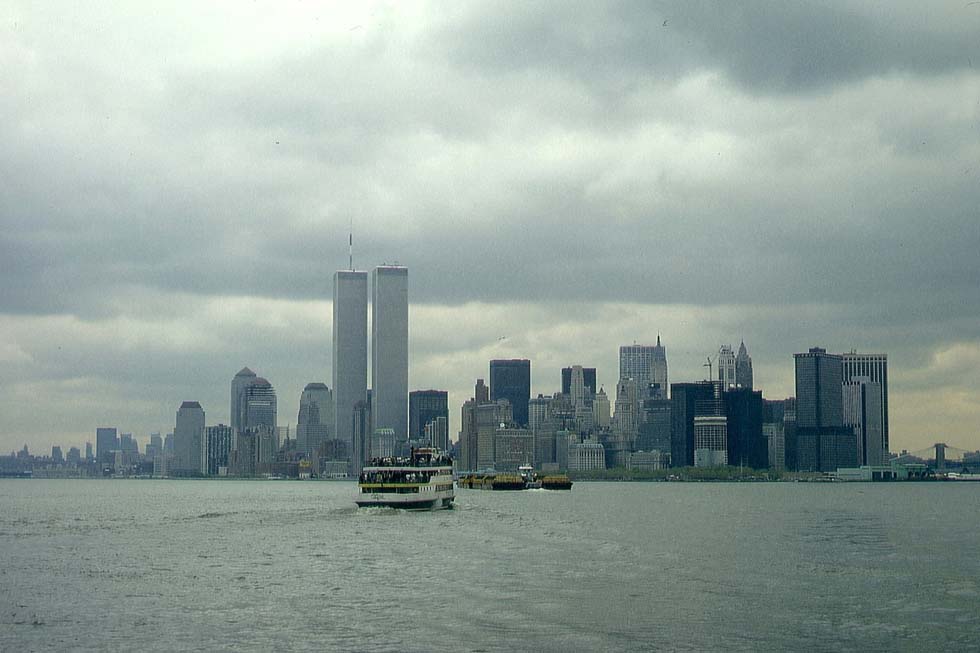
New York, 1987 (WS)
U.S. East Coast
During the age of sailing vessels, Abraham and son Samuel Cunard of Halifax were awarded a mail contract for a Newfoundland - Halifax - Boston - Bermudas route under sail. But steam shipping emerged, Robert Fulton demonstrated it in 1808 with his "Clermont" steaming up the Hudson River from New York to Albany. Mississippi shipping was built up by Fulton, financial sponsor Robert Livingston and engineer Nicholas J. Roosevelt. With the new railway age however, river and lake shipping suffered a severe setback. Nevertheless inland steam navigation provided the experience necessary for undertaking the historic first Atlantic crossing with the "Savannah" in 1891.
The "Savannah" continued her career with coastal shipping between Savannah, Georgia, and New York - under sail. In 1821 she ended at the coast of Long Island. Coastal steam navigation developed during the 19th century. One of the pioneers was Cornelius Vanderbilt. At the age of 16, he bought a small boat and started a ferry service between Staten Island and Manhattan. The business expanded to the Long Island Sound, then to Nicaragua and a transatlantic route. Vanderbilt became famous as the owner of the New York Central Railroad. And railways were not always the enemy of coastal shipping. Arthur D. Dubin ("Some Classic Trains") described the Mount Desert Limited train of 1887, which connected Boston with the Mount Desert Ferry terminal, where the passengers embarked on the Maine Central steamers "Sappho" or "Sebenoa" for Bar Harbor on Mount Desert Island, an appreciated tourist resort. The train connection, later from Washington, survived until 1960. A once-popular way for traveling from New York to Boston had been by the so-called Sound steamboats crossing the Long Island Sound, but from 1903 the all-parlor Merchants Limited train of the New Haven was victorious.
A route from New York via Halifax to St. John in Newfoundland off the Canadian coast was started in 1884 by the New York, Newfoundland S.S. Co. with the "Miranda". Later the Red Cross Line provided those services, e.g. in 1926 with the "Nerissa". In 1928 the company was sold to the Furness-Withy Group and the "Nerissa" became employed from 1931 on Bermudas and Trinidad services of their Bermuda & West Indies S.S. Co.
Before the USA entered World War I in 1917, the Official Guide of the Railways and Steam Navigation Lines of June 1916 listed East Coast local services of the Maine S.S. Co, the Boston & Yarmouth S.S. Co., the Eastern S.S. Co. with Eastport as the furthest destination in the north, the Merchants & Miners Trans. Co. connecting Boston with the Delaware Bay and the Chesapeake Bay, the Baltimore & Caro S.S. Co., the Brunswick S.S. Co. the Clyde S.S. Co. and the Richmond, Norfolk & Charleston S.S. Co. Between the wars the Savannah Line connected New York with that harbour of Georgia and of course there were many local services, too.
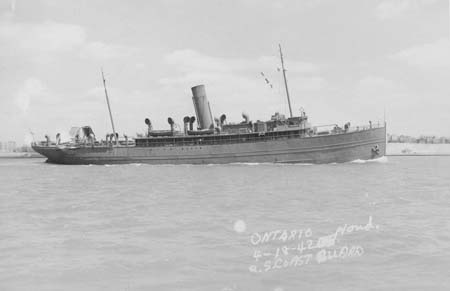
"Ontario", Merchants & Miners (old card, coll. WS)
|
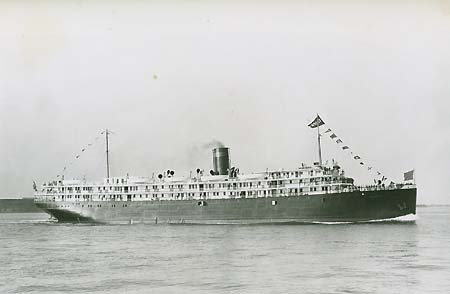
"Fairfax", Merchants & Miners, maiden trip from Boston, 1926 (old card, coll. WS)
|
 "Princess Anne", rebuilt, between Little Creek and Kiptopeke Beach (old card, coll. WS)
"Princess Anne", rebuilt, between Little Creek and Kiptopeke Beach (old card, coll. WS)
A sensation was created when the Virginia Ferry Corporation, operating ferries between Norfolk and Cape Charles, needed a new ship in 1933. They engaged Raymond Loewy, the progressive industrial designer, who had worked already for the Pennsylvania Railroad, affiliated with the shipping company. Loewy enjoyed the dazzling success of that new ferry "Princess Anne", passengers "danced or visited the snack-bar, they traveled and returned as if it would have been a cruise voyage", he wrote. Henceforth the tiny "Princess Anne", white with a cobalt-blue streamlined funnel and golden initials, was a model for styling future ocean liners and cruise ships. The lengthened "Princess Anne" however got a conventional funnel.
Almost half a century later, after the jet airlines' victory, the ABC Shipping Guide listed, apart from a Lion Ferry service Portland - Yarmouth with the car-carrying "Caribe" (obviously the former "Svea Star") only local car ferry services, such as the Maine State Ferry Service, the Wood's Hole, Martha's Vineyard & Nantucket S.S. Authority, various Long Island links, New York City Transport, the Delaware and Chesapeake Bay services and the North Carolina Dept. of Transportation. In the meantime hi-speed vessels were introduced by many companies, including the NY Waterway. After in 2006 the press reported insolvency of the widespread Sea Containers Group, their SeaStreak America hi-speed services New Jersey - Manhattan survived, acquired by the New England Fast Ferry Company. A tourist attraction is the ride along the Manhattan skyline on a sightseeing tour or past the Statue of Liberty by Staten Island Ferry. Listing all the ferry service providers and their routes in the USA or Canada would go beyond that worldwide survey - see the relevant Web sites.
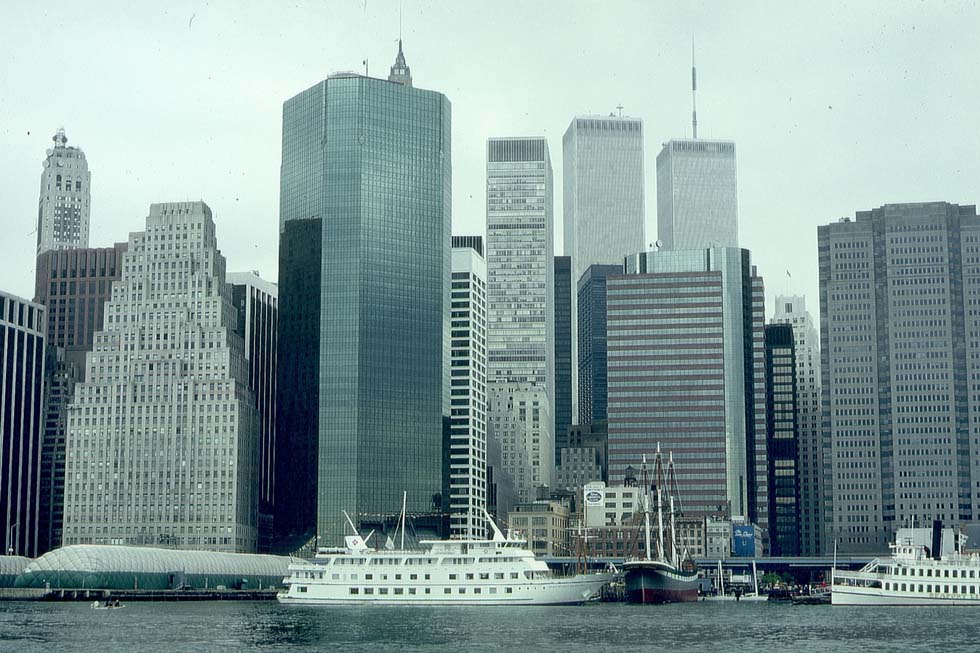
New York, Hudson River, 1987 (WS)
Canadian East Coast
Canada's main harbour on the Atlantic coast is Halifax, where already in 1831 the Halifax S.N.Co. started coastal services with the 364-ton paddle steamer "Royal William". In 1833 she crossed the Atlantic. When the British and North American Royal Mail Steam Packet Co. of Cunard started mail services Liverpool - Halifax - Boston in 1840, Samuel Cunard sent the small "Unicorn" to make docking arrangements and then she was used on a branch line from Pictou on the north coast of Nova Scotia to Quebec. Later regular ocean liners of Cunard, White Star, Canadian Pacific and Allan Line steamed up the St. Lawrence River - see the main chapter North Atlantic.
The Canada & Newfoundland S.S.Co. connected the island of Newfoundland in the North Atlantic. During WWI the Official Guide pointed out a Quebec S.S. Co. route Montreal - Quebec - Prince Edward Island, the Dominion & Atlantic S.S. Line Yarmouth - Boston, the Plant Line Port Sydney - Halifax - Boston, the Canadian Pacific routes and the Reid Newfoundland Railway S.S. Line services from Port Sydney to Port-aux-Basques in Newfoundland, where from 1898 its Cape gauge connected with St. John's. There another service of the company had its departure for Labrador, passing Newfoundland along the Atlantic coast.
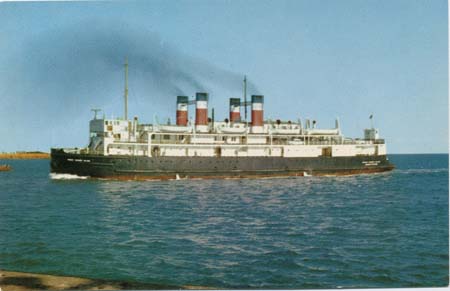
"Prince Edward Island", running between Cape Tormentine and Prince Edward Island (old card, coll. WS)
|
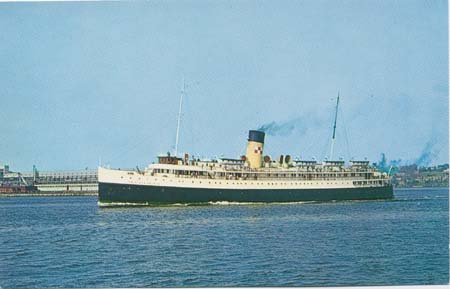
"Princess Helene", Canadian Pacific, running between St. John and Nova Scotia (old card, coll. WS)
|
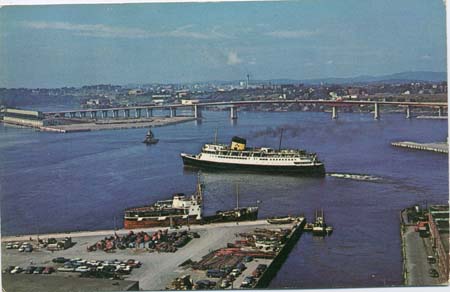 "Princess of Arkadia", Canadian Pacific, running between St. John and Nova Scotia (old card, coll. WS)
"Princess of Arkadia", Canadian Pacific, running between St. John and Nova Scotia (old card, coll. WS)
Ferry services to the islands off the Canadian East Coast always were necessary, but they became unprofitable. Canadian Pacific and the state-owned Canadian National Railway provided them during decades. Renamed Canadian Marine in 1979, car ferry services from Portland and Bar Harbor to Nova Scotia, from North Sydney to Newfoundland and from Lewisporte, Newfoundland, to Goose Bay, Labrador, were provided. The northernmost link was from Goose Bay to Nain with the "Bona Vista". Still further northward, into the icy Hudson Bay, went only once-yearly a cargo ship with the destination Churchill, the remotest railway terminus, connected with Winnipeg by an express train. An offer to facilitate the seaway into the Hudson Bay by Russian icebreakers was not welcomed.
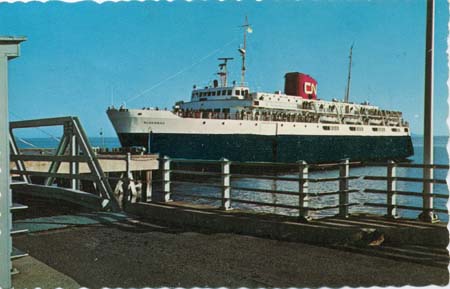 "Bluenose" of CN Marine, departing from Bar Harbour, bound for Yarmouth, N.S. (old card, coll. WS)
"Bluenose" of CN Marine, departing from Bar Harbour, bound for Yarmouth, N.S. (old card, coll. WS)
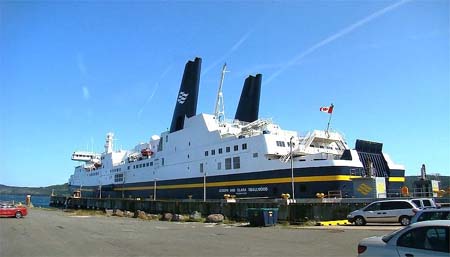
"Joseph and Clara Smallwood" of Marine Atlantic, Port-aux-Basques, Newfoundland (via Wikimedia)
|
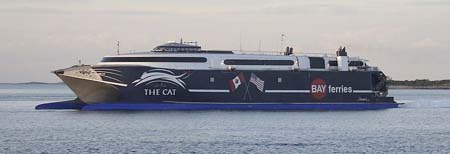
"The Cat" heading to Portland from Nova Scotia, 2007 (Jeffrey Ferland, via Wikimedia)
|
In 1986 Marine Atlantic took over from CN Marine and soon they got for Newfoundland services the "Caribou" and the "Joseph and Clara Smallwood", with c. 27,000 gt the largest icebreaking ferries of the world. In the 21st century the timetable pointed out traditional Bay Ferries with a hi-speed service Bar Harbor - Yarmouth, while the Prince of Fundy Cruises Portland - Yarmouth with the "Scotia Prince", the former "Stena Olympica", closed down in 2004. Marine Atlantic maintained Newfoundland services, in 2009 they introduced there the "Atlantic Vision" (the former "Superfast IX") and in 2010 two ro-pax vessels chartered from Stena Line replaced the "Caribou" and the "Joseph and Clara Smallwood". Always there were St. Lawrence Gulf services, river cruises and Newfoundland services by various companies. The Newfoundland and Labrador Department of Transportation maintained local routes and a service from Lewisporte on the east coast of Newfoundland to Goose Bay and Nain on the lonely Labrador Coast.
Canadian West Coast
The Canadian Pacific Railway completed the line across the continent to Port Moody in 1886 and to Vancouver in 1887. At Vancouver started the trans-Pacific steamship route of the Canadian Pacific Railway. An official brochure reported: "To meet competition (...) twelve eastbound voyages of the Pacific Empresses were continued from Vancouver southward to San Francisco (...). Later, in 1890, the "Danube" was placed on the run between Vancouver and San Francisco, but in the following year the company withdrew from this coastal service which was thereafter handled by the Union Steamship Co." The trans-Pacific CP steamers must have been the "Abyssinia", "Batavia" and "Parthia". A coastal route Vancouver - Victoria Island - Seattle was opened in 1904, for decades maintained by the Canadian Pacific Railway.
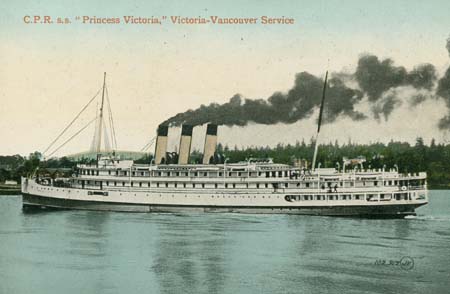 "Princess Victoria", Canadian Pacific, Victoria - Vancouver (old card, coll. WS)
"Princess Victoria", Canadian Pacific, Victoria - Vancouver (old card, coll. WS)
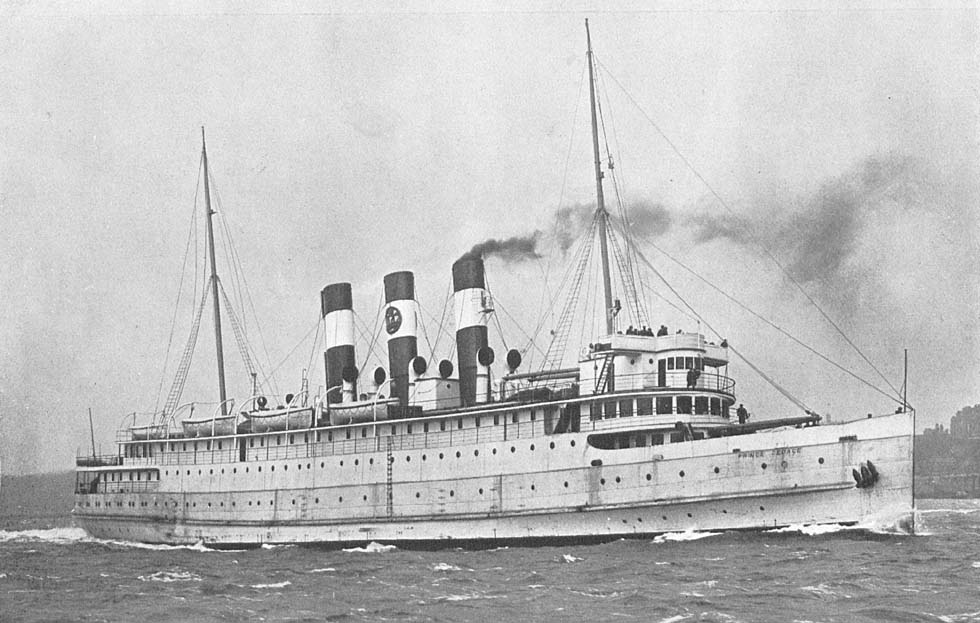
"Prince George", Grand Trunk Pacific Railway, 1910 (Deutsches Museum, Munich)
The Canadian Pacific got a competitor. The Grand Trunk Pacific, a daughter of the Grand Trunk Railway, reached in 1914 Prince Rupert, a harbour close to the border of Alaska. The Canadian Northern connected Vancouver from 1915. After WWI they were incorporated, together with the National Transcontinental, into the Canadian National Railway Co. Historian Laurence Dunn mentioned the coastal steamers "Prince George" and "Prince Rupert" (3,300 gt), built in 1910 in England for the Grand Trunk Pacific Railway, then the Canadian National Railway.
Years after, in 1925, the Canadian Pacific Railway introduced on the Vancouver - Victoria - Seattle route the new steamers "Princess Marguerite" and "Princess Kathleen" of 5,875 tons each, replacing two small ships of 1903 and 1908. The new black/white steamers with three buff funnels were praised as world's best coastal passenger ships. While the "Princess Marguerite" was sunk during WWII, the "Princess Kathleen" resumed Vancouver - Seattle services in 1947 and changed to the Alaska route in 1948. Three years later she collided with the "Prince Rupert" and in 1952 she stranded close to Juneau and was a total loss.
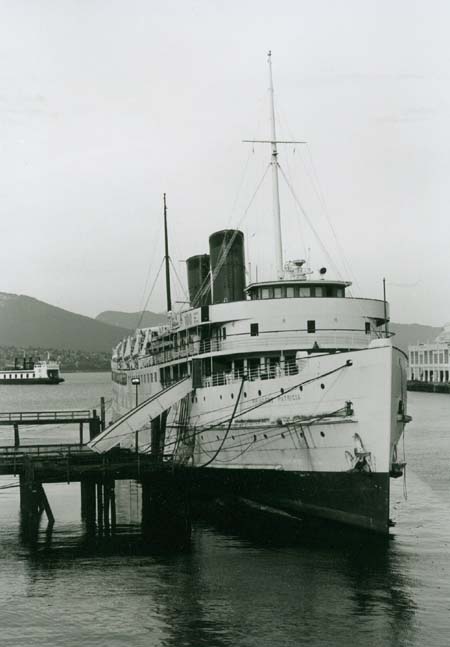
"Princess Patricia", a relic of Canadian Pacific, Vancouver 1985 (WS)
|
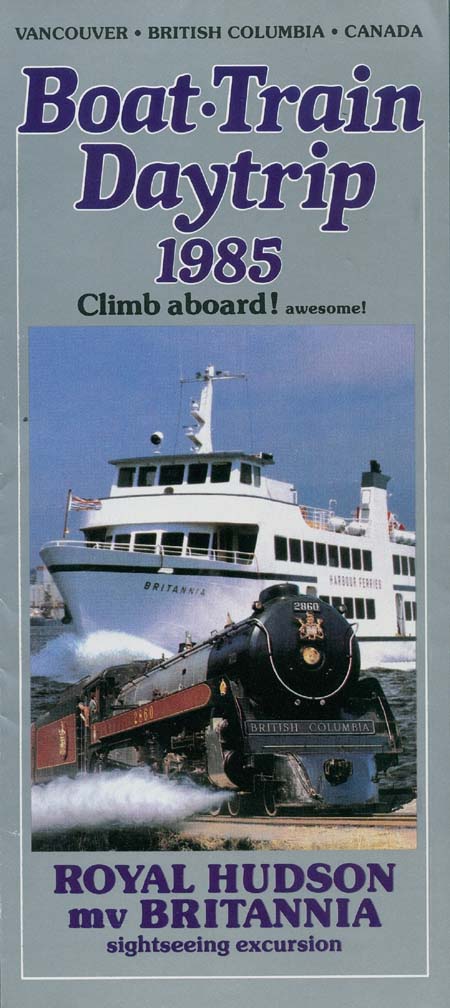
"Britannia" of Harbour Ferries and the 'Royal Hudson' for tours from Vancouver (coll. WS)
|
In the age of car ferries, BC Ferries, operating initially under more complicated labels, became dominating among the various shipping companies of the Canadian West Coast. A report by Richard Seville (in magazine Ferries, Dec. 2006) summarized: "Since foundation in 1958 and the decision to create a connection between the mainland and Vancouver Island independent from strikes, the once state-owned company BC Ferries had developed by growth and mergers into the biggest shipping firm of the region". From 1988 to 1991 there was a short interlude by the BC Stena Line with the "Crown Princess Victoria" (8, 897 gt), built in 1967 as "Patricia" for Svenska Lloyd. From 2007 BC Ferries (British Columbia Ferry Services) got new 17,800-ton car ferries from Germany, starting with the "Coastal Renaissance". The PacifiCat hi-speeds, unsatisfactory, were given away to Red Sea traffic. Victoria - Seattle services were then provided by the passenger-only hi-speeds of the American company Clipper Navigation.
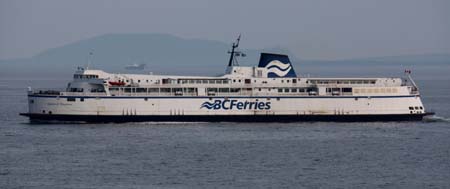 "Queen of Nanaino" of BC Ferries, coming into Vancouver (via Wikimedia)
"Queen of Nanaino" of BC Ferries, coming into Vancouver (via Wikimedia)
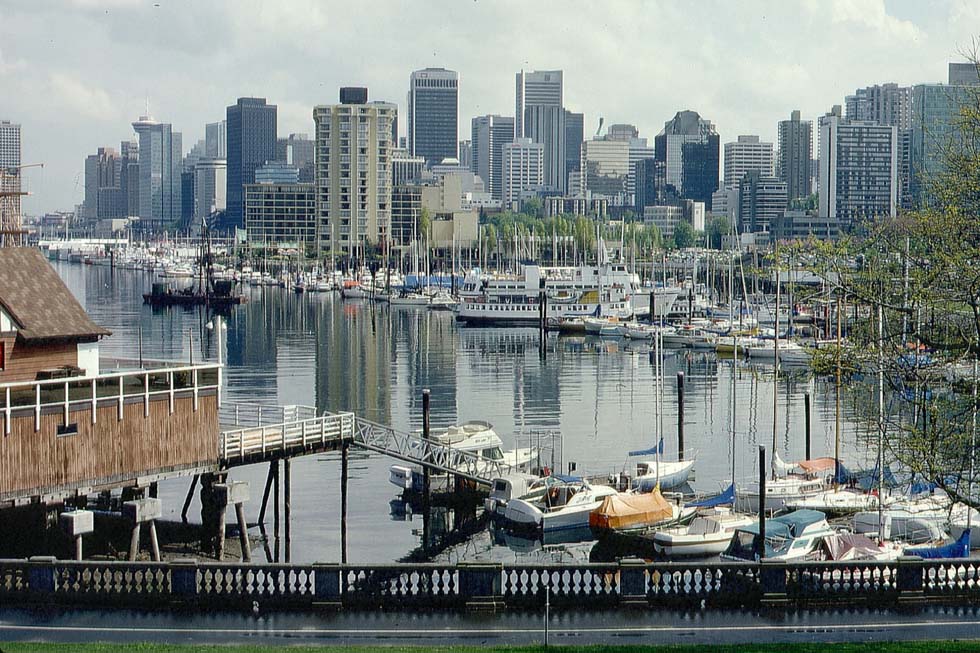
Vancouver, 1985 (WS)
U.S. West Coast
After the Mexican war ended in 1848, California became a part of the USA. Development of shipping in connection with the Panama Rail Road and then the Californian Golf Rush is dealt with the chapter South Atlantic/Caribbean & Central America. Completion of the transcontinental railway in 1869 brought a lasting setback to these shipping routes. At the Oakland Mole, the railway terminus, local paddle steamers connected with San Francisco's Market Street. Only when the expresses could use the Bay Bridge from 1938 until 1958, the Southern Pacific ferries were no longer the standard way to enter the city. For tourists still nowadays a trip with Golden Gate Ferries is a 'must'.
Seattle was connected with St. Paul by the Northern Pacific in 1900 and with Chicago by the Great Northern in 1905. About coastal shipping between Seattle and California, Arthur D. Dubin reported: "The year 1915 brought important development (...). The Great Northern Pacific Steamship Co. (jointly owned with the Great Northern) placed in service the 'Twin Palaces of the Pacific', S.S. "Northern Pacific" and S.S. "Great Northern". These twin beauties, America's fastest steamers, were 524 feet long and carried 800 passengers from Portland to San Francisco in 30 hours - 3 hours faster than the Southern Pacific's fastest express. WWII changed many things... The Great Northern's floating palaces became troop transports. The S.S. "Northern Pacific" caught fire at sea and was a total loss. The S.S. "Great Northern" returned to the Pacific Coast in 1922 under new ownership". The McCormick Line and other companies served the coast of California, too.
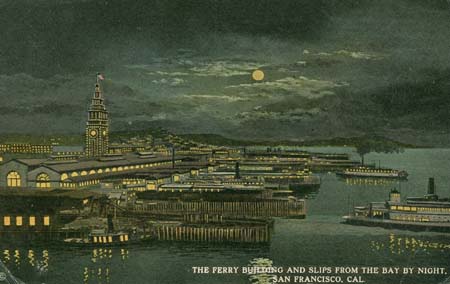
San Francisco, Ferry Building before WWI (old card, coll. WS)
|
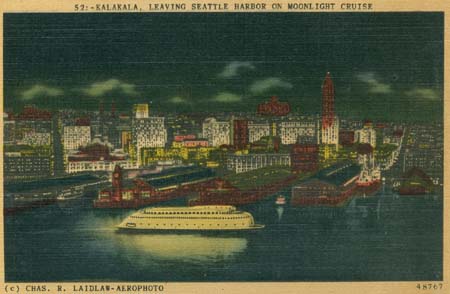
"Kalakala" leaving Seattle Harbor (old card, coll. WS)
|
During the age of car ferries, long routes have become scarce. A variety of companies continued providing local services. At the end of the 70s as well as nowadays there were mainly the local Puget Sound services, the Bay of San Francisco ferries and the boats connecting Los Angeles with nearby Santa Catalina Island. Services such as Seattle - Acapulco were cruises rather than regular routes. The most futuristic boat on the West Coast has been the "Kalakala", a 276-foot ferry, used between 1935 and 1967 on the Puget Sound. Streamlined almost like a space ship, she looked even more extravagant than Loewy's "Princess Anne". Rediscovered, she merits to become preserved, but for controversies see Wikipedia.
Alaska Services
The United States bought Alaska from Russia in 1867 for only 7.2 million dollars. Around the turn of the century a map (possibly not reliable) showed a steamer route from San Francisco to remote Nome on the Norton Sound, only some hundred miles distant from Siberia. Another route from San Francisco to Sitka on Baranof Island, north of Prince Rupert, was recorded. It's on the way to Skagway, which must have become an important port for coastal shipping at the latest in 1900, when the 3ft-gauge railway of the White Pass & Yukon Corp. departed there, connecting Canada's Yukon Territory - in good time for the gold rush.
It was followed by the discovery of copper in Alaska and in 1905 the Copper River & Northwestern started to build a railway from Cordova on the Prince William Sound. The timetable e.g. of 1916 pointed out the fastest connection with the Alaska Steamship Co. or Alaska Line from Seattle to Cordova and also its continuation to westward and peninsula points was mentioned. Seward on the Gulf of Alaska, close to Anchorage, became the more important port after the state-owned Alaska Railroad had been completed between that harbour and Fairbanks, thus making the territory less dependent on the Tanana and Yukon river shipping. Before WWII Alaska was served also by the Pacific SS Co. with The Admiral Line, which provided also other coastal services. From 1922 it was owned by the Dollar Line - see main chapter Pacific. A land route from the USA, the Alaska Highway, was built under military auspice during WWII and material was shipped via the port of Skagway. Of course a tunnel between Alaska and Siberia, proclaimed in the early 20th century by an "Interhemispheric Bering Strait Tunnel and Railroad Group" was only a dream.
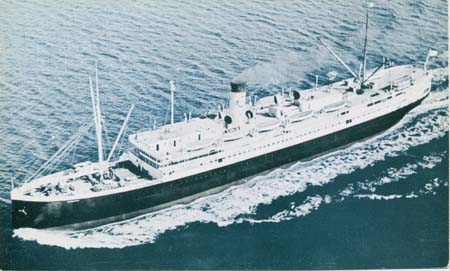
"Aleutian", Alaska Steamship Co. (old card, coll. WS)
|
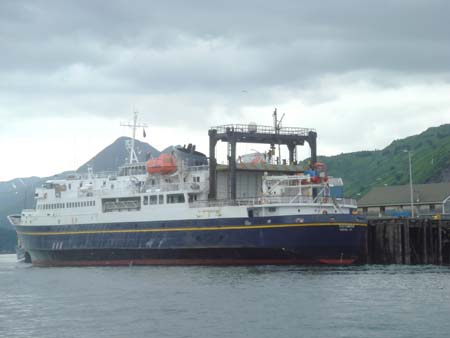
"Tustumena" of Alaska Marine Highway, Kodiak service, 2008 (Nancy Heise, via Wikimedia)
|
In 1959 Alaska became a state of the USA and in 1960 the "Chilkat" opened a car ferry service from Juneau. In 1963 coastal shipping was handed over to the Alaska Marine Highway System, which got new ferries, first for a Prince Rupert - Skagway service. A route to Kodiak Island followed. In 1967 Seattle was included. During the 70s the ABC Shipping Guide mentioned the service from Seattle through the picturesque Inside Passage to Skagway and the isolated one on the Gulf of Alaska from Cordova to Kodiak Island. Bellingham replaced in 1989 Seattle as port of departure. Flagship on the Skagway route has become the "Columbia", a dark-blue/white car ferry, introduced in 1974. The Aleutian Islands were connected by the little car ferry "Tustumena" of 1964 and the passenger-only "Bartlett" of 1969. Cook's timetable listed that service Kodiak - Unalaska once-monthly in summer and pointed out: "Attempts are made to offer regular schedules, but ports of call vary slightly and some of the ports served offer berthing accommodation which varies with the tides..."
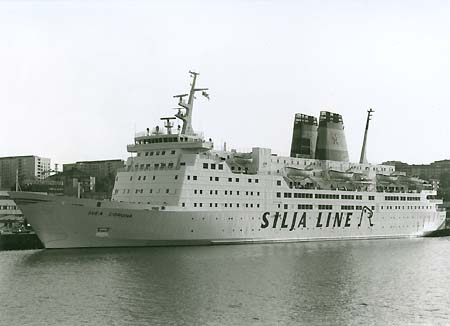 "Svea Corona" in 1982, the later "Sundancer" (WS)
"Svea Corona" in 1982, the later "Sundancer" (WS)
In 1984 the Johnson Line of Stockholm introduced together with Sundance Cruises a seasonal service Seattle - Alaska with the car ferry "Sundancer", the former "Svea Corona" (12,348 gt) of 1975. After running aground near Vancouver Island, she was refurbished at Piraeus as "Pegasus" for Epirotiki cruises. In 1985 Sundance put in service the car ferry "Stardancer" (27,000 gt), the former "Scandinavia" of the Bahamas route. Years later she was rebuilt into the cruise ship "Viking Serenade" of Royal Caribbean, then "Island Escape".
Hawaii Inter-Island
For tourists the one-week Hawaii round trip with Norwegian Cruise Line is nice. That may be one reason why local ferry services between Hawaiian Islands remained rather unknown abroad. Thomas Cook International Timetable mentioned (e.g. in 2005) only an itinerary Maui - Lana'i by Expeditions. In 2007 however, Ships Monthly reported: "The Austal USA yard at Mobile, Alabama, has floated out the first of two high-speed vehicle-carrying catamarans it is building for Hawaii Superferry. Designed to carry 866 passengers and 282 cars, the spectacular blue/white craft and her sister connect Honolulu to Maui and Kauai in three hours". A few months later, the International Herald Tribune (11th Oct. 2007) informed: "A judge has dealt another blow to the first passenger-vehicle ferry between major Hawaiian Islands, ruling that the service cannot run until it shows it will not harm the environment (...) focusing heavily on the ferry's possible danger to whales..." (while in Europe the whales were used as an argument against a tunnel to Denmark). A service O'ahu - Maui started in December 2007, but was suspended in March 2009. Wikipedia informed: "On July 2, 2009 a Delaware Bankruptcy Court granted the company's motion to abandon both the "Alakai" and "Huakai", ending all possibilities that the company may return to Hawaii."
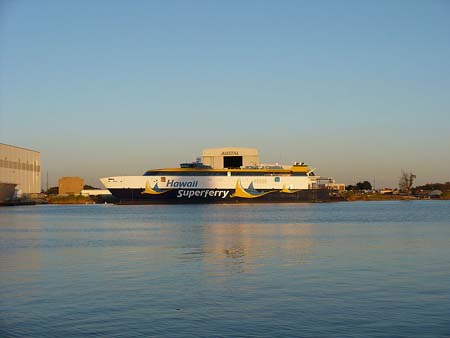 The second Hawaii Superferry under completion, 2008 (Altairisfor, via Wikimedia)
The second Hawaii Superferry under completion, 2008 (Altairisfor, via Wikimedia)
Passengers have to take airlines. Nevertheless Hawaii is a number-one tourist destination. Frommer's praised it: "...Hawaii is gorgeous, with an almost embarrassing richness of stunning beaches, hula girls and hunky Polynesian men... putting both locals and visitors in a friendly and mellow mood". It's the charm of Polynesia, of the South Pacific...
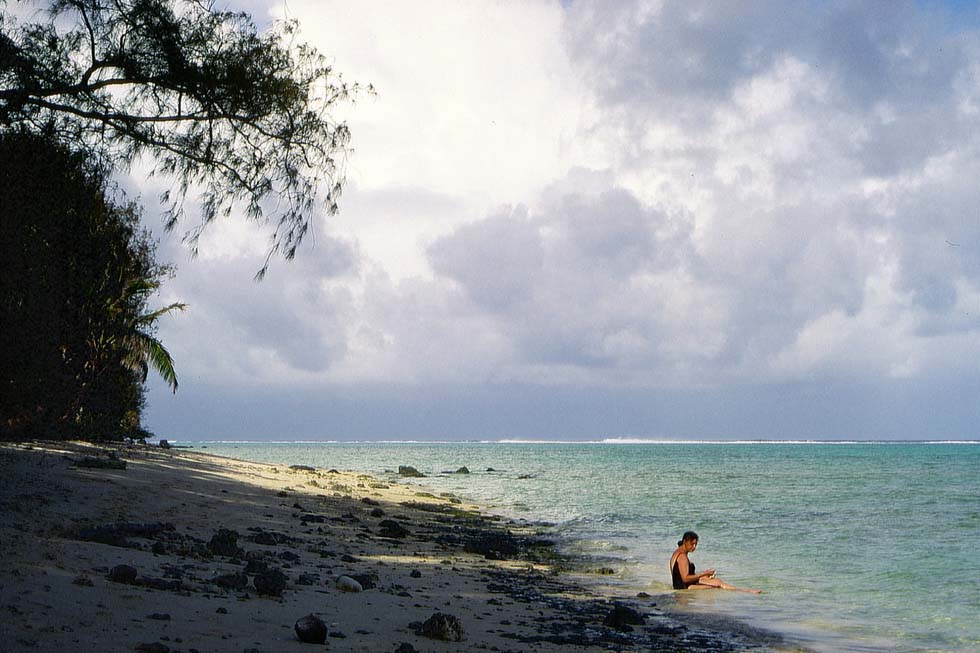
South Pacific (WS)
|